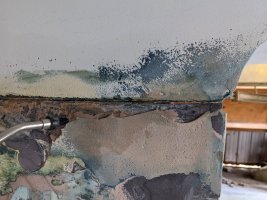For owners of E 38-200 and E 381:
I've read some threads here regarding water ingress at the keel bolts in the 38-200, and apparently it isn't that uncommon to have to drop the keel and resurface, re-bed, and re-torque the keel and keel bolts to stop the seepage/leaks. Some say every 5 -8 years this may need to be done. It's about a $5,000 job at the yard here in Southern California. Also, it seems that perhaps there isn't enough support at the rear of the keel (needing another couple of bolts) and this could be part of the issue. Also apparently there could be hull "settling" because the grid may not be able to support all the weight for some reason, which some attribute to the head door not closing properly (on the 381) or the v-berth door not closing (on the 38-200).
Questions are:
1. How big of a deal is this? (because it sounds like a pretty big deal)
2. Is this (keel seepage/leaks) more of an issue on the 38-200 models and not as much on the 381 models? (even though the 381 is the older/previous model)
3. What percentage of E 38-200 and/or E 381s have/had this issue?
(1%, 10%, half, basically all?)
4. If it is common then I just would need to add it to the list of recurring maintenance costs, (such as bottom paint every 2-3 years)
Thanks in advance for any input
I've read some threads here regarding water ingress at the keel bolts in the 38-200, and apparently it isn't that uncommon to have to drop the keel and resurface, re-bed, and re-torque the keel and keel bolts to stop the seepage/leaks. Some say every 5 -8 years this may need to be done. It's about a $5,000 job at the yard here in Southern California. Also, it seems that perhaps there isn't enough support at the rear of the keel (needing another couple of bolts) and this could be part of the issue. Also apparently there could be hull "settling" because the grid may not be able to support all the weight for some reason, which some attribute to the head door not closing properly (on the 381) or the v-berth door not closing (on the 38-200).
Questions are:
1. How big of a deal is this? (because it sounds like a pretty big deal)
2. Is this (keel seepage/leaks) more of an issue on the 38-200 models and not as much on the 381 models? (even though the 381 is the older/previous model)
3. What percentage of E 38-200 and/or E 381s have/had this issue?
(1%, 10%, half, basically all?)
4. If it is common then I just would need to add it to the list of recurring maintenance costs, (such as bottom paint every 2-3 years)
Thanks in advance for any input

